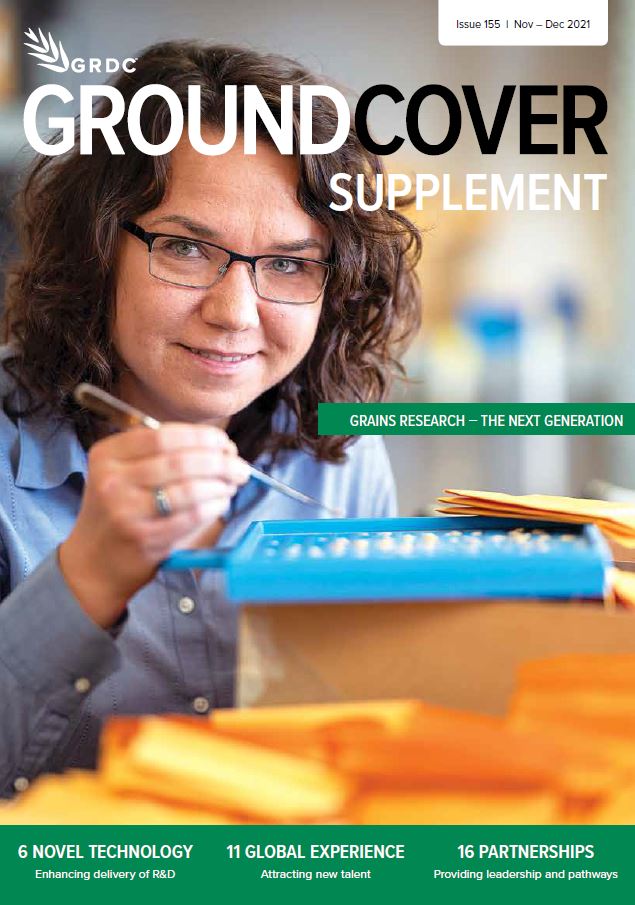This page shows the articles in of GroundCover.
GroundCover is also distributed every two months via mail. If you would like to subscribe to receive the hardcopy magazine, visit our subscription page.
Download supplement-

Discovery opens new front on charcoal rot research
Supplement: Grains research - the next generation, November-December 2021 - 2021-12-21T09:00:00+11:00Dr Barsha Poudel from the University of Southern Queensland is further developing her detective skills in crop pathology as part of a GRDC-supported capacity-building project. In collaboration with other researchers, she has discovered a new causal agent of charcoal rot, which will help inform management practices for the disease.
-

Wheat adaptation puzzle solutions
Supplement: Grains research - the next generation, November-December 2021 - 2021-12-19T09:00:00+11:00Puzzle solving is an important skill for scientists and David Cann has honed this skill further under the direction of a team of scientists on a GRDC capacity-building project. Mr Cann is focusing on winter wheat adaptation for changing climatic conditions.
-

Problem solver gets to grips with soil amelioration
Supplement: Grains research - the next generation, November-December 2021 - 2021-12-18T09:00:00+11:00Major investments by GRDC provide opportunities for capacity building of scientists for the grain industry. Dr Jian Jin’s involvement in a large soil amelioration project being managed by Professor Roger Armstrong from Agriculture Victoria at Horsham is such an example.
-

Capacity building to support ‘next-gen’ wheat
Supplement: Grains research - the next generation, November-December 2021 - 2021-12-16T09:00:00+11:00Cropping in changing climatic situations requires new tools and 100-day wheats may provide this opportunity. Tim Green is undertaking a GRDC capacity-building project conducting preliminary investigation into identifying traits essential for improving the performance and reliability of a wheat variety like this, a next-gen wheat.
-

Pulse establishment under investigation
Supplement: Grains research - the next generation, November-December 2021 - 2021-12-11T09:00:00+11:00Simulation modelling, together with field and pot trials, is showing pulses could be sown deeper and earlier to improve performance in regions of Western Australia, especially in regions where climate is changing. Honing her agronomy skills on a GRDC capacity-building project, Dr Sarah Rich enjoys contributing her insights and expertise to issues of priority for the Australian grains industry.
-

Synchrotron takes crop root studies to new levels
Supplement: Grains research - the next generation, November-December 2021 - 2021-12-10T09:00:00+11:00Networking is a key part of capacity building for young scientists and three GRDC-supported postdoctoral fellows have developed an industrious collaborative spirit to do this and ensure access has been maintained during COVID-19 lockdowns to a key facility for their work. The three fellows are using the ANSTO synchrotron facility to probe root-soil interactions to glean new knowledge to inform soil management practices for the Australian grains industry
-

Genetic solution to barley heat stress
Supplement: Grains research - the next generation, November-December 2021 - 2021-12-09T09:00:00+11:00GRDC is building scientific capacity to address priority issues such as heat tolerance of cereals. Dr Camilla Hill from Murdoch University brings years of experience to the task of improving barley heat tolerance and providing new genetics and molecular tools for Australian breeders.
-

Legacy created for Australian mungbeans
Supplement: Grains research - the next generation, November-December 2021 - 2021-12-08T09:00:00+11:00Legacy information is being generated for the Australian mungbean industry by improving the model component of APSIM Next Gen to provide insights to improve mungbean agronomic recommendations to reduce climate risks and yield variability. The work is underpinned by a GRDC-supported capacity-building project.
-

Role models nurture plant pathology skills
Supplement: Grains research - the next generation, November-December 2021 - 2021-12-07T09:00:00+11:00Genetic and pathology skills are being honed to support improved management of Sclerotinia stem rot through a GRDC-supported capacity-building project. Virginia Mwape only intended to come to Australia for a short course but, encouraged by Australia’s scientists, she has stayed on to complete a master’s and now a doctorate in philosophy, specialising in pathology.
-

Plant-pathogen intrigue drives research interest
Supplement: Grains research - the next generation, November-December 2021 - 2021-12-06T09:00:00+11:00Capacity building for pathology is key to developing up-to-date control measures for priority diseases in the grains industry. Kealan Hassett is one of many pathology postgraduates supported by GRDC and is focused on discovering more about the spot form of net blotch disease to inform growers’ management practices.
























































